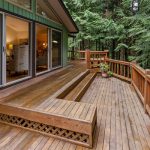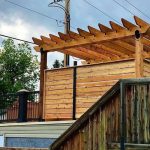Composite vs. Wood Decks in Calgary
Any homeowner looking to upgrade, renovate, or install a new patio or deck onto their property eventually has a decision to make. This decision may seem simple, but it is one of the single most important factors in how long their deck will last, how much work it will take to maintain, and how strongly it will stand up to the elements without splintering or warping.
As a homeowner building a deck, you will have to decide: do you want composite decking, or wood?
Comparing Composite vs. Wood Decking
While both sides have defenders that will argue every last one of the pros and cons of composite vs. wood decking, we’re just going to touch on some of the main comparisons. While they may look similar, these two materials have very different properties when it comes to the strengths and weaknesses.
Appearance
Let’s start with something simple: which material looks better? When composite boards were first introduced in the 1980s, they had a somewhat artificial and plastic-looking appearance, so you can be forgiven for thinking they remain that way even now. However, advances in the last few decades have made composite boards virtually indistinguishable from wood unless you’re right up close. They even have randomized grain patterns, copying the look of regular beams.
Cleaning
No matter which type of deck you get, you’ll have to do some basic cleaning 1-2 times a year with a mild soap and a low-pressure wash. This loosens dirt and debris, removes tree or plant material, and helps to wash away any natural chemicals, like tree sap, that might eat away at the boards’ protective layer. In this, both wood and composite are the same – if you want your deck to stay pristine, be sure to keep it clean!
Maintenance and Care
Aside from the washing, there are additional steps that must be taken to protect the wooden deck you’ve had built. Sanding, stains, sealants, and paints are necessary to keep moisture out, protect the wood from insect and UV damage, and inhibit rust from weakening the nails and screws throughout the structure. Without a renewed protective coat every 2-5 years, wood decks will rot or start to fail rather quickly.Composite decks, on the other hand, are made of durable and long-lasting materials that can handle weather extremes much better than wood. There is no need to stain or repaint every few years, and the harder, non-porous material means that moisture will not seep in and rot the deck from the inside out.
Resistance to Bends, Warping, and Splinters
As wood is exposed to hot and cold temperatures over multiple seasons, and the boards freeze and thaw, they are bound to crack, splinter, and bend. Because they absorb so much water by nature, this is nearly impossible to avoid, and at best can be mitigated with consistent maintenance and sealants. Even then, after 10+ years, wear will be evident, with broken, rotted, and bent wood pieces becoming apparent.Composite boards, without such high interior moisture, are far more resistant to warps and bends. Since they are designed with a tougher material on the outside, they also do not splinter off after extreme weather or pressure, making them safer for pets, children, and barefoot walking – not only at the start, but through the whole lifespan of the deck.
Overall Deck Longevity
Because of the moisture, difficulty of constant maintenance, and natural appeal to burrowing insects and rot, wood decks – in the very best instances, with perfect conditions – can last up to 30 years. This is generally much less, though, with many wooden decks getting at most 10-15 years before they must be replaced or rebuilt.Composite decks can last up to 50 years in ideal conditions, and generally last longer than wood in rough conditions overall. Small imperfections and unseen areas do not cause as many issues on composite decks, making them a great choice for people who want to simply build their deck and enjoy it without the need to refinish it every few years.
Price of Wood vs. Composite Decks
So composite decks come out on top in nearly every way – but surely there must be a reason why people still get wooden decks, right? Well, there is. It all comes down to price (and sometimes preference).
There are people who do enjoy the extreme natural look of wood, and even though it takes more work to maintain, they’re willing to do that in order to have that look. For most people, though, it’s just a matter of cost. Composite decking can cost $30-$45 per square foot, which adds up a lot faster than the $15-$25 for basic wood – especially when the deck is large or intricate.
However, it’s important to note that in almost every case, while the upfront cost may be higher for composite, the lifetime cost will be less. Homeowners need not spend thousands of dollars every few years to sand, strip, and re-stain their composite deck, nor replace boards that start to rot or mildew. It takes only a couple of years for the value to be equalized, so consider this when you’re thinking about the price.
If you have more questions about composite vs. wood decks, or want a quote on what one might cost for your home, get in touch with us today and we can walk you through the whole process – from permits and materials to finishes, styles, and even furniture. We can even provide you with a 3D rendering of your dream design, allowing you to see how it will look before a single pile is screwed in. After all, there’s nothing we love more than putting the finishing touches on another perfect backyard deck for a Calgary home!





